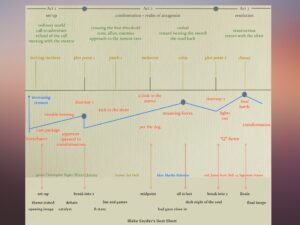The other night I watched a movie I would never have watched, generally speaking. It was the original Fast and Furious. I’m not into cars, or gangs, or racing, or…any of that stuff. But I am into story-telling, and I was curious as to why this movie has spawned a franchise that has lasted even beyond the tragic loss of its main actor. And it led me to saving the cat.*
I’ve done a deep dive into Blake Snyder’s Save the Cat books, both the original and Save the Cat Goes to the Movies.** I’d read the original a long time ago, but have a new appreciation for Snyder’s wisdom, however formulaic it may seem at first blush.
And F&F was the perfect vehicle (ha!) for me to test this. In fact, it was rather exciting to see how well Snyder’s beats work.
Save That Cat
If you haven’t read Save the Cat, Snyder was a screenwriter (also, tragically, no longer with us) who analyzed movies and determined that every good story can be defined by “beats”. He goes way beyond the traditional three-act structure, with 15 separate beats dividing the story line.
While watching F&F, I almost jumped out of my chair when I recognized several of these beats. The Theme was Stated (beat #2) when our young hero Brian claims that he only wants to win “respect”, not money or a car or even the girl. The B Story (beat #7) shows up right on time when Brian woos the girl by taking her to dinner. The All is Lost moment (beat #11) arrives when Brian reveals to the rest of the crew that he’s really an undercover cop, and the theme of respect shows up again in the Finale (beat #14) when Brian races Dominic in a heart-pounding near-death duel, with Brian letting Dominic off the hook for his illegal activities, while Dominic shows his respect for Brian’s integrity.
Now what does this have to do with novel-writing?
You may know that I’m a proponent of a new planning method called the Inside Outline, which I’ve used and taught and coached. While I’m normally a pantser*** when it comes to drafting my novels, the Inside Outline allows me to give a general structure to my nascent story, by developing my own “beats” that are linked by cause and effect.
But I think Snyder was really onto something, even if he applied it only to screenplays, and I will suggest that adding Snyder’s beats to an Inside Outline may help novelists visualize their story. The “beats” of Save the Cat are shorthand for the way all stories are structured, from way back to Aristotle.
Plot Paradigms
Take a look at the novel plot paradigm here. (You can download this as a pdf.) Compare the beats of the plot paradigm to Snyder’s beats and you can see that, really, these are labels for the same crucial moments that must appear in any story. For example, “refusal of the call” = “argument opposed to transformation” = “debate”, right?

Let me repeat that thought. The Save the Cat beats are, as are all plot points in all the old paradigms, crucial moments that must appear in any story.
I’ll be using Snyder’s beats as I develop my current work in progress. And I’ll let you know what I discover as I marry the cause and effect structure of the Inside Outline with the beat structure of Save the Cat.
Again, you can find Snyder’s two books here at my Bookshop affiliate link. Let me know if you, too, try using his beats to help structure your stories.
*”Saving the cat” is what Snyder believes a character must do at the beginning of a story in order to be “likable”. Not an actual cat, but a metaphoric cat.
**You can buy copies on Bookshop here; this is an affiliate link that benefits me, but also benefits indie booksellers.
***See more on “pantser” here.
